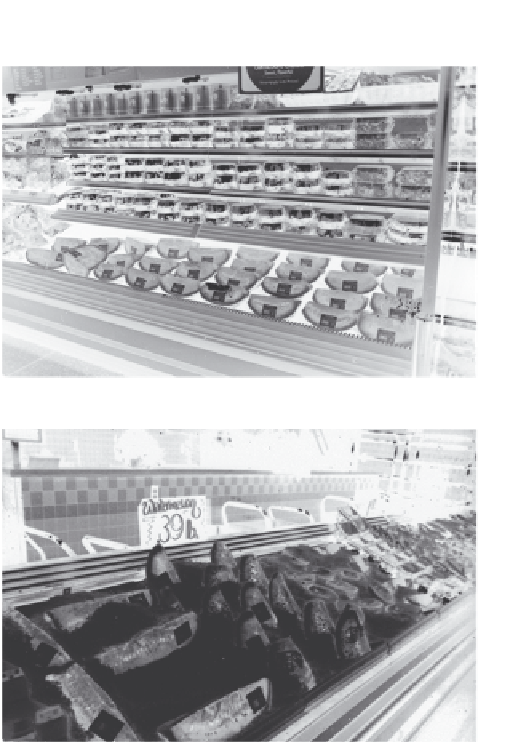Agriculture Reference
In-Depth Information
Cantaloupe cubes stored in modified-atmosphere
package (5% O
2
, 10% CO
2
) suppressed microbial growth
more than those held in normal air at 5°C (Bai
et al
. 2001).
Packages flushed with the gas mixture had higher visual
quality than those in which the product modified the
internal atmosphere.
Surface sanitation of whole fruits is critical to reduce
contamination of the pulp during cutting operations. In a
study by Ayhan and Chism (1998), whole fruit surfaces
were sanitized by scrubbing with 200 ppm active chlorine
at pH 6.0, sliced into cubes and dipped in 50 ppm
chlorine prior to packaging in 5% oxygen atmosphere.
Acceptable quality was maintained for 15 days at 2.2°C;
2000 ppm chlorine was not more effective than 200 ppm,
and no off-odours or flavours were noted by taste panellists.
Sapers
et al
. (2001) found that washing whole cantaloupe
with 5% hydrogen peroxide was more effective in sanitizing
the rind than 1000 ppm chlorine or other commonly used
sanitizing treatments. In another study, cut cantaloupe
cylinders had a potential post-harvest life of 15 days at
5°C, following a 1-minute dip in 2.5% calcium chloride at
60°C (Luna-Guzman
et al
. 1999). This treatment signifi-
cantly retarded softening. Fresh-cut watermelon has a
porous texture, making it difficult to rinse after processing;
therefore, whole fruit sanitation and cooling to 5 °C prior to
and during processing were critical to significantly reduce
microbial growth, extending post-harvest life to 8 days
during subsequent storage at 3°C (Durigan
et al
. 1996).
The enormous variety found in cucurbits presents
challenges in maintaining post-harvest quality during
commercial harvest and handling operations. By applying
the principles and techniques presented in this chapter,
growers and shippers should be able to provide consistently
high-quality produce to their clients.
(a)
(b)
Figure 14.29
Fresh-cut products are more commonly
displayed in (a) refrigerated displays than
(b) crushed ice displays due to better temperature
management and longer post-harvest life.
Edible portion for 'Millionaire' seedless watermelon was
significantly lower at 43.9%, where 33.1% was considered
suitable for fresh-cut chunks (30-50 g each) and 10.8%
consisted of unusable pieces that could be converted into
juice or another product (Durigan
et al
. 1996).
Storage at 4°C maintained acceptable quality in fresh-
cut cantaloupe for 4 days and honeydew melon for 14 days,
based on ratings of trained sensory panellists and microbial
counts (O'Connor-Shaw
et al
. 1994). At the retail level,
studies by Durigan
et al
. (1996) determined that refrigerated
display cases maintained critical temperatures better than
display in crushed ice cases (Figure 14.29a, 14.20b).
Successful efforts to extend post-harvest life of fresh-cut
cantaloupe involved combinations of treatments, including
more effective sanitizing, use of calcium solutions and
modified-atmosphere packaging.
REFERENCES
Abbott, J. A., A.R. Miller and T.A. Campbell. 1991. Detection
of mechanical injury and physiological breakdown of
cucumbers using delayed light emission. J. Amer. Soc.
Hort. Sci. 116 (1), 52-57.
Adaskaveg, J.E, H. Forster and N.F. Sommer. 2002. Principles
of postharvest pathology and management of decays of
edible horticultural crops. In, Kader A.A. (ed.), Postharvest
Technology of Horticultural Crops. University of California.
Agr. & Nat. Resources Pub. 3311. pp. 163-196.
Ahoaroni, Y., A. Copel and E. Fallik. 1993. Storing 'Galia'
melons in a controlled atmosphere with ethylene absorbent.
HortScience 28 (7), 725-726.
Artes, F., A.J. Escriche, J. A. Martinez and J.G. Marin. 1993.
Quality factors in four varieties of melon (
Cucumis Melo
, L.).
J. Food Quality 16, 91-100.






























